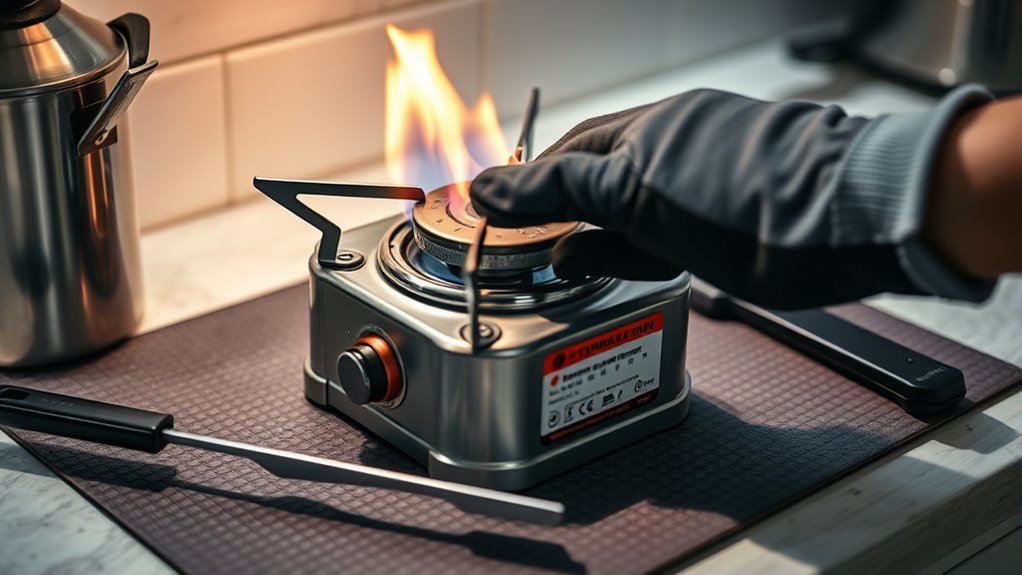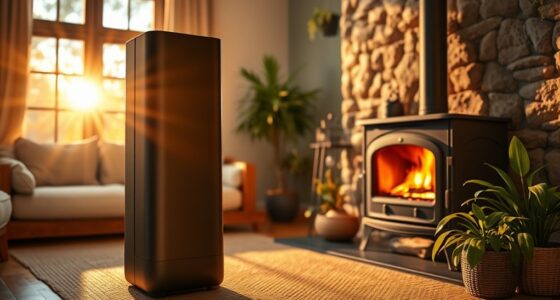During power outages, using a small stove safely means ensuring proper ventilation to prevent gas buildup and carbon monoxide poisoning. Always operate the stove outdoors or in well-ventilated areas, check for leaks before use, and keep a fire extinguisher nearby. Avoid leaving it unattended and keep children and pets away. After cooking, ventilate the space and let the stove cool completely before storing. Following these precautions will help keep you safe; learn more to stay fully protected.
Key Takeaways
- Use the stove outdoors or in well-ventilated areas to prevent gas buildup during power outages.
- Ensure all connections are secure and check for leaks before igniting the stove.
- Keep a fire extinguisher nearby and never leave the stove unattended while in use.
- Avoid operating the stove in enclosed spaces without proper ventilation, especially during outages.
- After use, allow the stove to cool completely and ventilate the area to disperse residual gases.

When the power goes out unexpectedly, a small stove can become an essential tool for cooking and heating your food. However, using it safely is vital to prevent accidents and guarantee your well-being. One of the most important considerations is ventilation safety. Small stoves, especially those fueled by propane or butane, release gases that can quickly fill a room if not properly ventilated. Always set up your stove in a well-ventilated area, preferably outdoors or in a space with open windows and good airflow. Never use a small stove inside a closed room or in a confined space without ventilation, as this can lead to dangerous carbon monoxide buildup, which is odorless and deadly. Installing a carbon monoxide detector nearby is a wise precaution to alert you if gas levels become unsafe.
Fuel storage is another critical aspect to think about before using your small stove. Properly storing fuel is essential to prevent leaks, fires, or explosions. Keep fuel containers tightly sealed when not in use, and store them outside your living space in a cool, dry, well-ventilated area away from direct sunlight, heat sources, or open flames. Never store large quantities of fuel indoors, and avoid storing fuel near your stove or pilot lights. When you need to refill or handle fuel, do so carefully, ensuring you don’t spill any and that you dispose of empty containers responsibly. Always follow the manufacturer’s instructions regarding fuel types and storage guidelines. Using appropriate fuel is crucial for safe operation and to prevent dangerous incidents.
Before igniting the stove, double-check that all connections are secure and that there are no leaks or damage to the fuel lines. If you smell gas or detect a leak, turn off the stove immediately and ventilate the area. Never attempt to repair fuel lines or appliances yourself unless you’re qualified; instead, seek professional help. During use, keep a fire extinguisher nearby and be prepared to shut off the stove quickly if necessary. Never leave the stove unattended while it’s in use, and make sure that children and pets are kept away from the appliance. Once you’ve finished cooking or heating your food, turn off the stove and allow it to cool completely before storing or handling it again. Additionally, consider portable power options, such as inverter generators, to ensure you can operate essential devices safely and efficiently during outages. Proper ventilation, including the use of exhaust fans or open windows after use, is also vital during and after operation to prevent any residual buildup of dangerous gases. Using a small stove during a power outage can be safe and effective when you prioritize ventilation safety and proper fuel storage. Taking these precautions helps protect you and your loved ones, giving you peace of mind while managing your food and heat needs during unexpected outages.
Frequently Asked Questions
Can Small Stoves Be Used Indoors Safely During Outages?
Yes, you can use a small stove indoors safely during outages if you follow ventilation precautions and fire safety measures. Always guarantee the area is well-ventilated to prevent carbon monoxide buildup, and never leave the stove unattended. Keep flammable materials away, have a fire extinguisher nearby, and check that the stove is in good working condition. These steps help you stay safe while using your stove indoors during power outages.
What Type of Small Stove Is Safest for Emergency Use?
They say “safety first,” and when choosing a small stove for emergencies, it’s best to opt for a butane or propane tabletop stove. These cooking alternatives are portable, easy to use, and allow for proper stove safety when used in well-ventilated areas. Always follow manufacturer instructions, avoid indoor use without ventilation, and keep a fire extinguisher nearby. This way, you stay prepared without risking safety during power outages.
How Do I Prevent Carbon Monoxide Poisoning When Using a Small Stove?
To prevent carbon monoxide poisoning when using a small stove, always guarantee proper ventilation by opening windows or vents. Never operate the stove in a confined space without fresh air. Additionally, install carbon monoxide detectors in your home, especially near sleeping areas, and check them regularly. These precautions help detect dangerous levels of CO early, keeping you safe while you use the stove during power outages.
Are There Specific Storage Tips for Small Stoves During Power Outages?
Your small stove’s storage safety is vital; don’t just shove it into any corner. Instead, select a dry, ventilated space away from flammable materials, ensuring proper stove placement. Keep it upright and secure to prevent accidental tipping. Store it in a cool, well-ventilated area, and avoid clutter around it. Proper storage helps maintain its condition and keeps your home safe during power outages, avoiding disaster with every use.
What Maintenance Checks Are Needed Before Using a Small Stove in an Emergency?
Before using your small stove in an emergency, you should check its ventilation to guarantee proper airflow and avoid carbon monoxide buildup. Inspect the fuel supply for leaks, cracks, or debris that could cause issues. Make sure all connections are secure and that the stove is clean. Performing these maintenance checks helps prevent accidents and ensures safe, efficient operation during power outages.
Conclusion
So, next time the power’s out and you’re craving that gourmet meal, remember: safety first, or you might end up auditioning for a fire safety commercial. Small stoves can be your best friend—if you treat them like a delicate, slightly mischievous pet rather than a reckless, fire-breathing dragon. Keep vents open, never leave it unattended, and maybe, just maybe, consider a backup plan that doesn’t involve roasting marshmallows on a potential disaster. Stay safe and cook smart!











